Experiment on Spray Cooling Performance with Different Additives of Different Mass Fraction
2016-09-05WangYuZhouNianyongQianXiaohuiJiangYanlong
Wang Yu, Zhou Nianyong, Qian Xiaohui, Jiang Yanlong
College of Aerospace Engineering, Nanjing University of Aeronautics and Astronautics,Nanjing 210016, P.R. China
(Received 25 July 2015; revised 15 November 2015; accepted 19 November 2015)
Experiment on Spray Cooling Performance with Different Additives of Different Mass Fraction
Wang Yu, Zhou Nianyong, Qian Xiaohui, Jiang Yanlong*
College of Aerospace Engineering, Nanjing University of Aeronautics and Astronautics,Nanjing 210016, P.R. China
(Received 25 July 2015; revised 15 November 2015; accepted 19 November 2015)
As an efficient cooling method for high heat flux field, spray cooling has a great application potential on aircraft directed energy weapon cooling. Based on previous research results, an experimental system of open-loop spray cooling was established, and the potassium chloride aqueous solutions and ethylene glycol aqueous solutions with different mass fractions were applied to investigate the influence of different additives on spray cooling system performance. Besides, theoretical analysis was conducted according to the droplet breakage principle and the characteristic parameters of fluid mechanics. The results indicate that heat transfer can be enhanced by adding potassium chloride up to a certain concentration and then decrease with higher concentration. Heat transfer is deteriorated with the increase of ethylene glycol concentration. Both of the two additives can reduce the freezing point of the system, and ethylene glycol is preferred to improve the application range of the system in consideration of the corrosion of salt solution.
spray cooling; potassium chloride; ethylene glycol; heat transfer coefficient
0 Introduction
Directed energy weapon which is regarded as the standard configuration for fighters of next generation has attracted more and more attention. Power in the magnitude of megawatt can be produced within several seconds after the launch of the directed energy weapon, which leads to high heat load and high heat flux of hundreds and thousands of watts per square centimeter on weapon surface. Under high operating capacity, large amount of exhaust heat will impair the performance and reliability of the weapon. Therefore, to dissipate the heat is of great importance.
In the spray cooling process, cooling medium is atomized into countless droplets and then be sprayed to the heating surface to remove the exhaust heat. It has the advantages of small temperature difference, no boiling hysteresis, good heat transfer performance, uniform surface temperature and low requirement of cooling medium[1-6]. Meanwhile, it has been widely applied in many fields, such as electronic equipment cooling, medical treatment and steeling[7-12],etc. Therefore spray cooling owns an application potential in the field of aircraft directed energy weapon cooling.
As a commonly investigated hot topic, water spray cooling has a wide application range. The influence of additives on spray cooling performance has been studied by many researchers. Cui[13]investigated the influence of soluble salt and gas on spray cooling performance, and found that adding soluble salts (NaCl, Na2SO4, MgSO4) to water would enhance the heat transfer performance of spray cooling in non-boiling condition and nucleate boiling condition. Kim[14]summarized the results of Cui[13]and considered that dissolved gas and solids could enhance the heat transfer performance of spray cooling system. Under the mass fraction of 1%, NaHCO3in cooling medium could be resolved to Na2CO3and CO2, which can both promote the expansion and boiling of droplets. Lin[15]combined different mass fractions of methyl alcohol with water to carry out an experiment and proposed that the heat flux of mixed working medium was between the value of water and that of pure methyl alcohol. Liu et al.[16]studied the spray cooling with water and water with additives using Doppler velocity sonar, the studied results presented that additives could not only cause smaller droplets but also make spray cooling system boiling under a lower surface temperature, which could enlarge the application range and ensure system safety of spray cooling. Qiao et al.[17]used sodium dodecyl sulfate solution with the mass fraction of 0.01% as a cooling medium and found that surface temperature was reduced by using the additive. Jia et al.[18]carried out experiment on the same solution as Qiao et al.[17], and found that a lower superheat rate and a safety critical temperature could be achieved.
For aircraft spray cooling system, both of the optimization of spray cooling performance and the adaptability of the system should be considered. In standby condition in winter or severe flight condition, system may not operate normally using water as cooling medium due to the cabin temperature below 0 ℃. The use of auxiliary heating system will consume extra energy and take a long time to warm up the system, which makes the spray cooling system non-available in an emergency situation. In contrast, adding different types of additives can reduce the freezing point and the characteristics of the cooling medium in order to extend the system application range and improve system reliability. To investigate the influence of different additives, an open-loop spray cooling system was established. Salt additives and alcohol additives are the commonly used additives in water. A typical salt additive and alcohol additive were selected to make up different ratio of solution as the cooling medium, and then different spray cooling characteristics were studied.
1 Experiment in Open-Loop Spray Cooling System
1.1Experimental setup
Schematic diagram of the open-loop spray cooling system is shown in Fig.1.
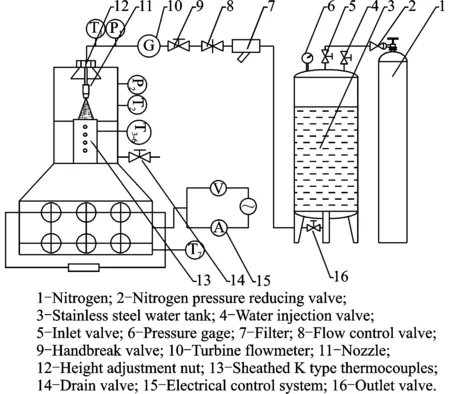
Fig.1 Schematic diagram of water spray cooling system
In the loop, water is pressurized by the nitrogen firstly. Then it flows to the outlet valve, which controls the close and open of the spray. After the outlet valve, it flows into the flow control valve, the handbrake valve and the turbine flowmeter in sequence. The turbine flowmeter is used to obtain the volume flow rate. After the flowmeter the cooling medium sprays onto the heating surface. A drain valve is set for eliminating the water from the spray chamber timely.
The structure of spray chamber is shown in Fig.2. It can be seen that the heating assembly consists of six cartridge heaters, a copper block and an insulating layer.
Nozzle with the type name of 1/8GG-SS1 manufactured by SPRAY Co. was selected. This type of nozzle is an atomization nozzle. The nozzle and its injection are shown in Fig.3. Nozzle parameters are listed in Table 1. Besides, inlet temperature of the nozzle is 20 ℃.
Physical map of the system is shown in Fig.4.
1.2Different solution parameters
Based on previous research results on the experimental setup, the distance between nozzle and heating surface was 18 mm. During the experiment, the heating power was 1 400 W causing the heat

Fig.3 Nozzle and its injection
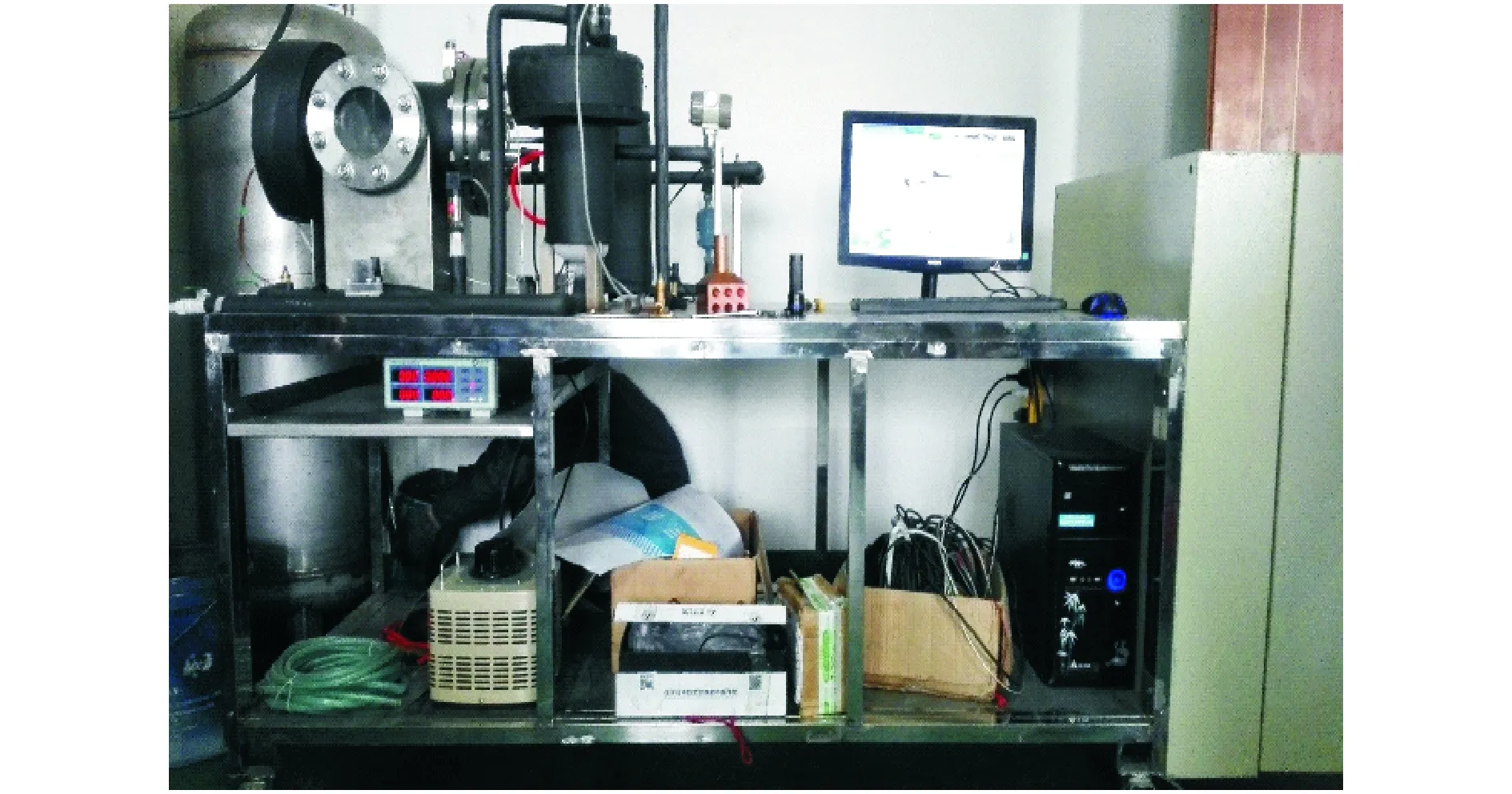
Fig.4 Physical map of water spray cooling system
transfer in non-boiling area, and parameters such as heat flux, surface temperature difference and heat transfer coefficient of different solutions are analyzed with the variation of spray inlet pressure.
The mass fractions of potassium chloride solution were set to 0.5%, 1%, 2%, 5% and 10%, respectively at the temperature of 20 ℃. Relevant parameters of these solutions are shown in Table 2[19].
The mass fractions of ethylene glycol solution were set to 1%, 3%, 5%, 10% and 20%, respectively at the temperature of 20 ℃. Relevant parameters are shown in Table 3[19].

Table 2 Parameters of potassium chloride solution

Table 3 Parameters of ethylene glycol solution
1.3Procedures
Steps of the experiment are as follows:
(1) Mass fractions of additives were selected and solutions were modulated;
(2) Spray height was adjusted to 18 mm and heating power was adjusted to 1 400 W;
(3) The nitrogen storage tank and pressure reducing valve were opened while inlet pressure was adjusted to a required value;
(4) System heat balance was considered to be achieved when heating surface temperature kept stable in 30 min;
(5) Inlet pressure was adjusted from 0.45 MPa to 0.85 MPa in turn;
(6) After the test heating system should be shut down and cooling system should still operate until the temperature of the heating surface returned to normal.
2 Theoretical Analysis
2.1Theoretical equations
The heating copper block was processed and thermocouples were embedded in the heating block, as shown in Fig.5. Thermocouples 1, 2 and 3 were located at 10 mm intervals. The distance between Thermocouple 4 and the heating surface was 15 mm. The heating surface diameter was 28 mm.
It is assumed that the insulation was covered well on the heating block that heat only conducts along Y direction(as shown in Fig.5), then the heat flux can be expressed by the Fourier law as follows
(1)
Liner fitting is done for four thermocouples

(2)
Heat flux, surface temperature can be expressed as

(3)
(4)
whereλis the thermal conductivity of copper (3.95 W/(cm·K)) and Δy the distance between Thermocouple 1 and the heating surface, with its value of 45 mm.
Surface heat transfer coefficient, another key parameter of heat transfer performance, can be expressed as
(5)
where q is the heat flux (W/cm2), Q the heat volume (W), Twthe heating surface temperature (℃), and Tinthe water inlet temperature (℃).
When adding additives to water, parameters such as density, boiling point, freezing point, specific heat, viscosity, thermal conductivity and surface tension, which all have great influence on spray cooling performance, are changed due to the increase of mass fraction. Former research[20]indicated that spray cooling performance in non-boiling regime was mainly influenced by dimensionless parameters, such as the Weber number We, the Reynolds number Re, the Prandtl number Pr and evaporation intensity, which can be expressed as
(6)
(7)
(8)
(9)
Based on the above equations, surface heat transfer coefficient can be expressed as
(10)
where h is the convection heat transfer coefficient (W/(cm2·K)),λthe thermal conductivity of the solution(W/(cm·K)) , D the equivalent diameter of heating surface (cm), d the Sauter mean diameter (SMD) (m), Tsatthe saturation temperature of cooling medium (℃),μthe viscosity (mPa·s), Cpthe specific heat transfer (kJ/(kg·K)),σthe surface tension (N/m) and u0the spray velocity (m/s). According to Ref.[17], it can be expressed as follows
(11)
where Cqis the flow rate correction coefficient, with its value between 0.6 and 1 based on nozzle characteristics, Δp is the pressure difference inside and outside the nozzle (Pa), andρis the density of the cooling medium (kg/m3).
The variation of surface tension affects the Weber number We. According to droplet breakage mechanism, the break of droplets or liquid film indicates that the Weber number is greater than the critical Weber number. Therefore, the smaller the surface tension is, the easier the droplets overcome their own surface tension to be atomized into small droplets. This can enhance spray cooling performance[21-22]. Meanwhile with the change of viscosity and thermal conductivity, Reynolds number and Prandtl number vary. From Tables 1,2, it can be concluded that there is a limited decrease on thermal conductivity and a great increase on viscosity.
With the increase of mass fraction of additives, the Reynolds number decreases while the Prandtl number increases. Moreover, the Weber number may increase or decrease depending on the additive′s type. Based on Eq.(10), extreme value point of the Nusselt number may appear. This means that cooling performance will not simply be improved or reduced after adding additives. For further investigation on the effect of salt additive and alcohol additive, experiments on solutions with different mass fraction were developed in this paper.
2.2Uncertainty
The maximum uncertainty of the sheathed K type thermocouple is ±0.8 ℃. The maximum uncertainty of fitting the slope of four thermocouples is ±0.01 ℃. The distance between thermocouples is decided by processing technology with the uncertainty of ±0.1 mm. The water inlet temperature is obtained by a PT100 platinum resistor, whose maximum uncertainty is ±0.15 ℃.
Based on error transfer functions[23], on this experimental setup, the uncertainty of heat flux, surface temperature, as well as heat transfer coefficient can be expressed as
(12)
(13)
(14)
The uncertainty of heat flux, surface temperature and heat transfer coefficient are ±4.9%, ±2.8% and ±5.6%, respectively.
3 Results and Discussions
3.1Potassium chloride solution
The variations of heat transfer coefficient and surface temperature difference of potassium chloride solution obtained from the experiment above are displayed in Figs.6, 7.
As shown in Fig.6, under each inlet pressure, heat transfer coefficient of the heating surface increases with the increase of mass fraction of potassium chloride until the mass fraction reaches 1%, and then decreases with the increase of mass fraction. For example, under inlet pressure of 0.45 MPa and mass fraction of 1%, heat transfer coefficient of potassium chloride solution is 3.9 W/(cm2·K). Compared with heat transfer coefficient of pure water which is 4.0 W/(cm2·K), heat transfer coefficient has a slight increase after adding potassium chloride. Meanwhile, heat transfer coefficient increases with the increase of spray inlet pressure, because higher pressure leads to higher droplet velocity and the atomization effect is enhanced. Under high inlet pressure, the increasing rate of the heat transfer coefficient caused by the solution mass fraction is smaller than that under low inlet pressure.
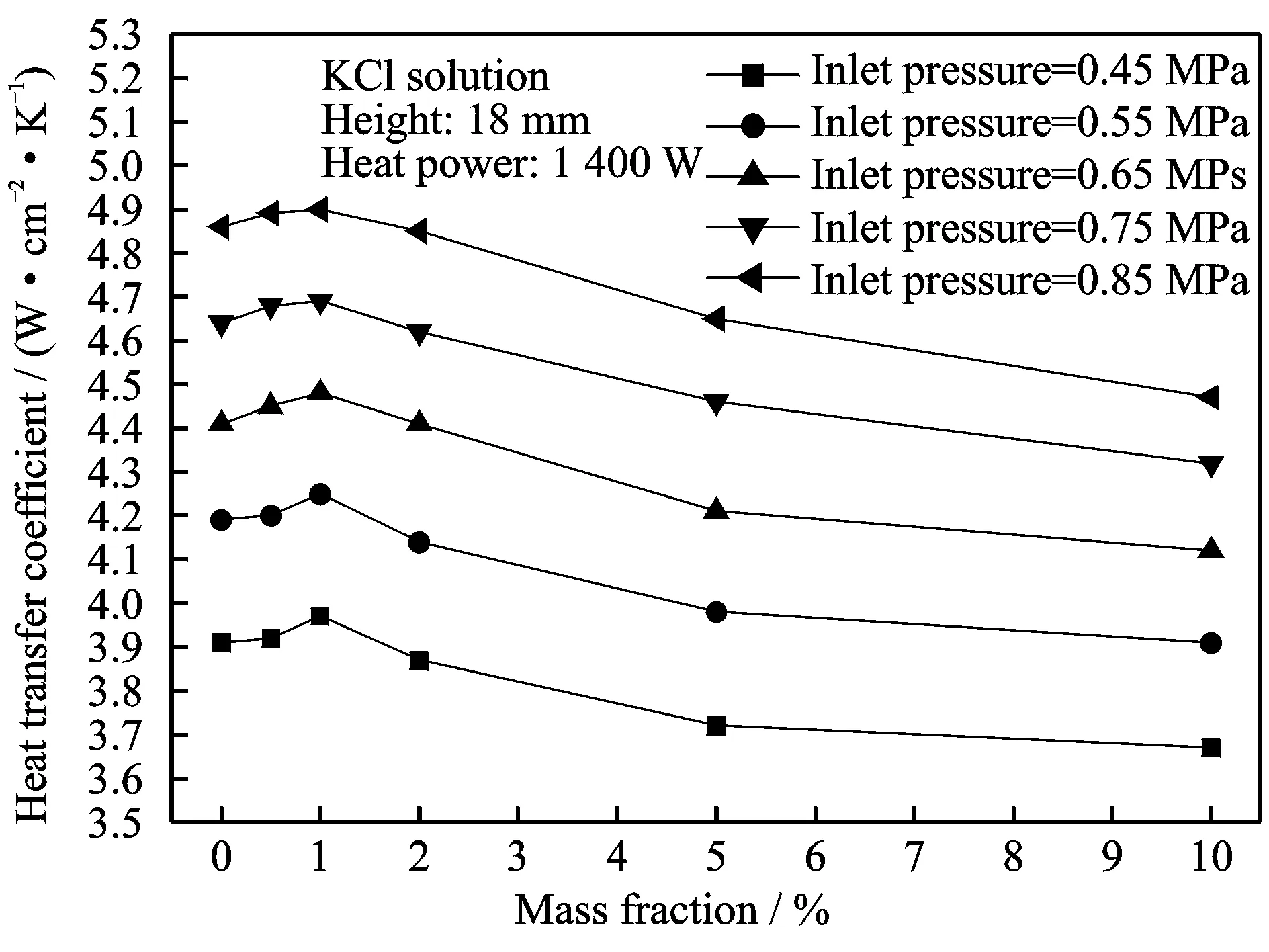
Fig.6 Variations of surface heat transfer coefficient with mass fraction of potassium chloride under different inlet pressures
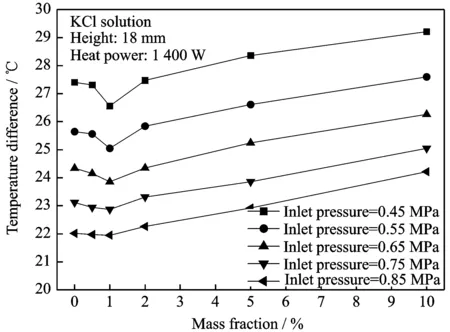
Fig.7 Variations of surface temperature difference with mass fraction of potassium chloride under different inlet pressures
As shown in Fig.7, heating surface temperature difference has a trend of decreasing firstly, and then increases with the increase of mass fraction of potassium chloride. The smallest temperature difference appears under the mass fraction of 1%. Another trend seen from Fig.7 is that temperature difference decreases with the increase of inlet pressure. Under high inlet pressure, the decreasing rate of surface temperature difference is less than the value under low inlet pressure, which means salt additives have more significant effect under low inlet pressure. Therefore, heat transfer enhancing effect of salt additives is limited. Moreover, salt solution will corrode the heating surface after a long period. Although salt solution has the lower freezing point than water which can enlarge system application range, it is still not recommended to be applied to aircraft spray cooling system.
3.2Ethylene glycol solution
3.2.1100% pure ethylene glycol
Due to the poor heat transfer performance of pure ethylene glycol, base temperature of the heating block will exceed 400 ℃ and the heating block will be burned out under heating power of 1 400 W. So heating power of this test is set as 1 100 W. Results are displayed in Figs.8—10.

Fig.8 Variations of heat flux with inlet pressure of pure ethylene glycol
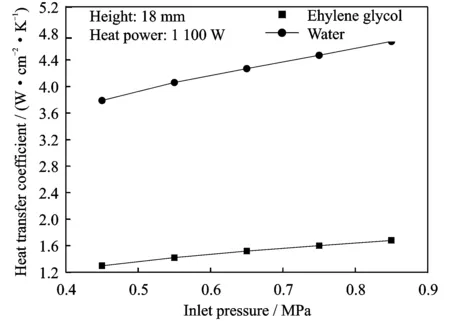
Fig.9 Variations of surface heat transfer coefficient with inlet pressure of pure ethylene glycol
It can be observed from Figs.8—9 that the heat flux of pure potassium chloride is less than that of water. This means that, under the same heating power, heat transfer ability of potassium chloride is weaker than that of water. In addition, surface heat transfer coefficient of potassium chloride is much less than that of water. This is because the viscosity of potassium chloride is higher than that of water while the thermal conductivity is lower than that of water. As a result, droplets velocity as well as liquid film fluidity become worse, thereby deteriorating the heat transfer performance of the system.
As shown in Fig.10 surface temperature difference is much higher than that of pure water, which is extremely unfavorable for the stealth performance of aircraft.

Fig.10 Variations of surface temperature difference with inlet pressure of pure ethylene glycol
3.2.2Ethylene glycol solution under different mass fractions
The variations of heat transfer coefficient and surface temperature difference of ethylene glycol solution obtained from the experiment above are displayed in Figs.11, 12.
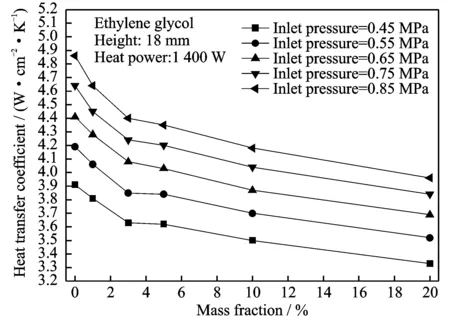
Fig.11 Variations of heat transfer coefficient with mass fraction of ethylene glycol under different inlet pressures
In Fig.11, surface heat transfer coefficient under different inlet pressure decreases with the increase of mass fraction of ethylene glycol. Under inlet pressure of 0.85 MPa and mass fraction of 20%, surface heat transfer coefficient is 3.96 W/(cm2·K) which decreases by 18.52% compared with that of water (4.86 W/(cm2·K)). Meanwhile, under inlet pressure of 0.45 MPa, the decreasing rate is 14.83%.
It can be observed from Fig.12 that surface temperature difference increases with the mass fraction of ethylene glycol, which means that adding ethylene glycol to water is detrimental to heat transfer performance. However, adding ethylene glycol can reduce the freezing point and improve the application range. According to ASHRAE Handbook 2005, the relationships between freezing point and mass fraction of ethylene glycol are listed in Table 4. When aircrafts operate in winter of North China, spray cooling system would not operate normally using water as cooling medium due to the low cabin temperature below 0 ℃.In this case, adding some ethylene glycol to spray cooling system will make the system operate normally and save the energy of preheating the cooling medium.

Fig.12 Variations of temperature difference with mass fraction of ethylene glycol under different inlet pressures
3.3Discussion using dimensionless parameters
The Reynolds number, Prandtl number and Weber number were calculated on the basis of Tables Table 4Relationships between freezing point and mass fraction of ethylene glycol 1, 2. In the calculation process, the SMDs of these solutions were calculated by equations provided by the nozzle manufacturer[24-25].

Massfraction/%0510152025Freezingpoint/℃0-1.4-3.2-5.4-7.8-10.7
Based on previous research[26-27], the Reynolds number is the most critical dimensionless number in influencing heat transfer coefficient. As shown in Fig.13 (a), with the increase of mass fraction of Potassium chloride, velocity of droplets decreases due to the increase of medium density. The decrease of velocity and the increase of viscosity lead to the obvious decrease of Reynolds number. Meanwhile, it can be seen from Fig.13 (b) that with the increase of mass fraction of ethylene glycol, velocity of droplets decreases and viscosity of droplets increases, thus leading to an obvious decrease of Reynolds number, whose decreasing rate is larger than that of potassium chloride solution.

Fig.13 Variations of Reynolds number with mass fraction under different inlet pressures
From Fig.14 (a), it can be observed that in general, Weber number of potassium chloride solution has an increasing trend with the mass fraction, but the increasing rate decreases gradually. This is because surface tension and density of the solution both increase gradually, which causes the increase of SMD. Meanwhile the increase of surface tension has an inhibitory effect on the increasing rate of Weber. As shown in Fig.14 (b), with the increase of mass fraction, Weber number of ethylene glycol solution has an increasing trend, and the increasing rate is larger than that of potassium chloride solution. This is because surface tension decreases while SMD increases by the effect of large viscosity, both of which promote the increase of the Weber number.

Fig.14 Variations of Weber number with mass fraction under different inlet pressures
The Prandtl numbers of each inlet pressure are consistent because the Prandtl number calculation is only related to fluid properties. As shown in Fig.15(a), the Prandtl number of potassium chloride solution has an increasing trend which is higher than that of water and increases rapidly under low mass fraction. This is because thermal conductivity decreases rapidly under low mass fraction and then decreases slowly due to the ionization effect of potassium chloride solution. Meanwhile, it can be seen from Fig.15 (b) that the Prandtl number of ethylene glycol solution has an increasing trend. In the mass fraction range from 0 to 10%, the increasing rate of Pr in ethylene glycol solution is less than that in potassium chloride solution due to the small change of thermal conductivity. This is because ionization does not happen in ethylene glycol solution.
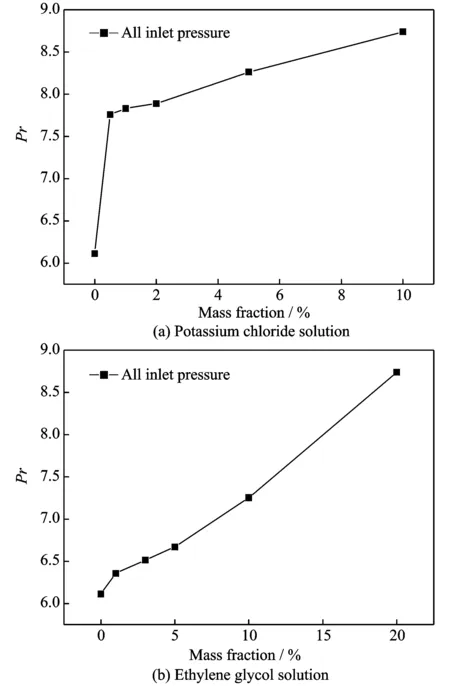
Fig.15 Variations of Prandtl number with mass fraction under different inlet pressures
To sum up, under low mass fraction, due to the ionization effect of potassium chloride solution, the heat transfer coefficient increases and Re decreases. Meanwhile We nearly remains unchanged. Temperature difference decreases in Fig.7 which meansεdecreases under low mass fraction. From Eq.(10) it can be concluded that the Prandtl number has a dominant influence on spray cooling heat transfer performance which makes heat transfer coefficient increasing with the increase of mass fraction; with continuous increase of mass fraction, Reynolds number becomes the primary influencing factor due to the increase of viscosity and surface tension. As a result, surface heat transfer coefficient decreases with the increase of mass fraction.
Besides, under low mass fraction of ethylene glycol due to the inexistence of ionization, the increasing rate of the Weber number and the Prandtl number is less than the decreasing rate of Reynolds number. Therefore, heat transfer coefficient decreases with the increase of mass fraction. Viscosity still increases when mass fraction continues to increase, making the effect of Reynolds number more significantly. Thus, heat transfer coefficient still decreases.
By the way, the spray inlet pressure has a significant influence on the heat transfer performance. For the increase of droplet velocity and droplet size caused by the increase of inlet pressure, Re and We both increase, thus influencing the heat transfer performance more obviously than that of solution mass fraction. This work investigates the influence of different additives on spray cooling heat transfer performance, without in-depth discussion on the influence of inlet pressure.
4 Conclusions
An open-loop spray cooling experimental setup was established to investigate the influences of salt solution and alcoholic solution on spray cooling performance. Conclusions are drawn as follows:
(1) In this experiment, heat transfer performance is enhanced by adding potassium chloride to mass fraction of 1% and then weakened by adding potassium chloride. Heat transfer performance is impaired constantly by adding ethylene glycol to water. Besides the pure ethylene glycol has the worst performance.
(2) For the low mass fraction of salt solution, surface heat transfer coefficient increases with the increase of mass fraction because Pr has a major influence to spray cooling performance; and then with the increase of mass fraction, Re replaces Pr to be the major influencing factor that surface heat transfer coefficient decreases with the growth of mass fraction.
(3) For low mass fraction of alcohol solution, surface heat transfer coefficient decreases with the increase of mass fraction because the decreasing rate of Re far outweighs the increasing rate of Pr and We. Moreover, with the increase of mass fraction, Re plays a more significant role so that heat transfer coefficient still decreases.
(4) For the aircraft spray cooling system, in the interest of safety operation under severe operating conditions, some alcohol additives can be added into the cooling medium to reduce freezing point with a slight decrease of cooling performance. Salt additives can result in the same effect, but its corrosion to heating surface makes it unrecommended in aircraft spray cooling system.
[1]WAEHTERS L H J,WESTERLING N A J. The heat transfer from a hot wall to impinging water drops in the spheroidal state [J]. Chemical Engineering Science, 1966, 21(11):1047-1055.
[2]PEDESEN C O. An experimental study of the dynamics behavior and heat transfer characteristics of water droplets impinging upon a heated surface [J]. International Journal of Heat and Mass Transfer, 1970, 13(2):369-381.
[3]ZHANG J Z, TAN X M, LIU B, et al. Heat transfer on grinding workpiece surface subjected to mist/air impinging jet [J]. Journal of Nanjing University of Aeronautics and Astronautics, 2012, 44(5): 741-746. (in Chinese)
[4]SENDA J, YAMADA K, FUJIMOTO H, et al. The heat transfer characteristics of a small droplet impinging upon a hot surface [J]. JSME International Journal, SeriesII, 1988,31(1):105-111.
[5]YANG W H, ZHANG J Z. Experimental study of HTC for film cooling of parallel-inlet holes [J]. Transactions of Nanjing University of Aeronautics and Astronautics, 2012, 29(1): 46-53.
[6]YANG W H, LU C M, ZHENG J W. Experimental investigation on cooling effectiveness of film-effusion cooling [J]. Journal of Nanjing University of Aeronautics and Astronautics, 2014, 46(4): 517-523. (in Chinese)
[7]ALIA T, TUQAN KRISTEN M. Evaluation of single versus multiple cryogen spray cooling spurts on in vitro model human skin [J]. Lasers in Medical Science 2005(20): 80-86.
[8]XIN H, ZHOU Z Z, CHEN B, et al. Comparative analysis of single droplet evaporation models in cryogen spray cooling [J]. Journal of Engineering Thermophysics, 2009, 30(4): 653-656.(in Chinese)
[9]NELSON J S, MILNER T E, ANVARI B, et al. Dynamic epidermal cooling during pulsed laser treatment of protwine strain: a new method-logy with preliminary clinical evaluation[J]. Arch Dermatol, 1995,131:695-700.
[10]MAJARON B, AGUILARA G, BASINGERA B, et al. Sequential cryogen spray for heat flux control at the skin surface[C]∥ Proc SPIE.[S.l.]:[s.n.],2001.
[11]ZHOU H Q. Experimental investigation of pulsed spray cooling on a hot surface [D]. Tianjin, China: Tianjin University,2007. (in Chinese)
[12]AN Q L, FU Y C, XU J H, et al. High efficiency cooling technology based on green manufacturing [J]. Transactions of Nanjing University of Aeronautics and Astronautics, 2005, 22(3): 230-233.
[13]CUI Q. The effect of dissolving salts or gases in water sprayed on a hot surface [D]. Toronto: University of Toronto,2001.
[14]KIM J. Spray cooling heat transfer: The state of the art [J].International Journal of Heat and Fluid Flow, 2007, 28(4):753-767.
[15]LIN C, Harris R. Spray cooling with methanol and water mixtures [C]∥ 9thAIAA/ASME Joint Thermophysics and Heat Transfer Conference. Sanfrancisco, California:AIAA,2006.
[16]LIU Z H. Effect of cooling water quality on mist cooling of hot surface [J]. Iron and Steel,1998,33 (3):16. (in Chinese)
[17]QIAO Y M, Chandra S. Spray cooling enhancement by addition of a surfactant [J]. Transactions of the ASME, 1998, 120: 92-98.
[18]JIA W, QIU H H. Experimental investigation of droplet dynamics and heat transfer in spray cooling[J]. Experimental Thermal and Fluid Science, 2003 (27): 829-838. (in Chinese)
[19]LIU G Q, MA L X, LIU J. Handbook of chemical property data [M].Beijing, China: Chemical Industry Press,2002. (in Chinese)
[20]WANG Y Q, LIU M H, LIU D, et al. Heat transfer performance of inclined spray cooling in non-boiling regime[J]. CIESC Journal, 2009, 60(8): 1912-1919. (in Chinese)
[21]KANG B S, KYUNG J C. Cooling of a heated surface with an impinging water spray [J]. Journal of Heat Transfer, 1998, 12(4): 734-740.
[22]BERNARDIN J D, MUDAWAR I. Film boiling heat transfer of droplet streams and sprays [J]. International Journal of Heat and Mass Transfer, 1997, 40: 2579-2593.
[23]KLINE S J, MCCLINTOCK F A. Describing uncertainties in single sample experiments[J]. Mechanical Engineering, 1953, 75(1): 3-7.
[24]OUYANG Y D. Design and algorithm of temperature transmitter signal processing software [J]. Journal of Data Acquisition and Processing, 2012, 27(2): 396-398. (in Chinese)
[25]Spraying Systems Co. Handbook of Industrial Spray Nozzles[M]. Wheaton: Spraying Systems Co., 2012.
[26]Han F Y. Study on heat transfer performance, enhancement and surface temperature non-uniformity in spray cooling [D]. Hefei, China: University of Science and Technology of China, 2011. (in Chinese)
[27]Zhang W. Investigation of heat transfer characteristics of spray cooling on micro grooved surface [D]. Xuzhou, China: China University of Petroleum, 2013. (in Chinese)
Mr. Wang Yu is a Ph.D. candidate in Nanjing University of Aeronautics and Astronautics (NUAA). His research interests focus on the heat transfer method with high efficiency.
Mr. Zhou Nianyong is a Ph.D. candidate in NUAA. His research interests focus on the experimental heat transfer.
Mr. Qian Xiaohui is a Ph.D. candidate in NUAA. His research interests focus on the heat transfer method with high efficiency.
Dr. Jiang Yanlong is a professor and doctoral supervisor in NUAA. He received his Ph.D. degree in Zhejiang University. His research interests focus on the heat transfer and refrigeration.
(Executive Editor: Zhang Tong)
, E-mail address: jiang-yanlong@nuaa.edu.cn
How to cite this article: Wang Yu, Zhou Nianyong, Qian Xiaohui, et al. Experiment on spray cooling performance with different additives of different mass fraction[J]. Trans. Nanjing Univ. Aero. Astro., 2016,33(3):375-385.
http://dx.doi.org/10.16356/j.1005-1120.2016.03.375
TK124Document code:AArticle ID:1005-1120(2016)03-0375-11
杂志排行
Transactions of Nanjing University of Aeronautics and Astronautics的其它文章
- Advances in Technologies of Piezoelectric Pumping with Valves
- Numerical Optimization on Aerodynamic/Stealth Characteristics of Airfoil Based on CFD/CEM Coupling Method
- Kinematic Calibration of Asymmetricly Actuated 6-DOF 3-PPPS Parallel Mechanism
- Kinematic Optimization of Bionic Shoulder Driven by PneumaticMuscle Actuators Based on Particle Swarm Optimization
- Dynamic Modeling and Adaptive Fast Nonsingular Terminal SlidingMode Control for Satellite with Double Rotary Payloads
- A Comprehensive Review on RNA-seq Data Analysis
